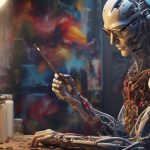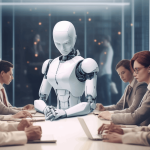In today’s rapidly evolving world, technology continues to reshape industries, pushing boundaries and unlocking new creative possibilities. One such revolutionary force in the creative industry is generative AI tools. These powerful tools are transforming the way artists, designers, and marketers approach their work, unleashing a wave of innovation and creativity.
Generative AI tools are capable of creating new content, designs, and ideas by analyzing vast amounts of existing data and generating unique outputs. Whether it’s painting a masterpiece, composing a song, or designing a website, these tools have the ability to push creative boundaries and bring fresh ideas to life.
With generative AI tools, the possibilities are endless. They offer a unique combination of human creativity and machine intelligence, generating results that were once unimaginable. Artists can now explore uncharted territories, designers can create captivating visuals, and marketers can enhance their campaigns with personalized experiences.
The impact of generative AI on the creative industry
Generative AI has had a profound impact on the creative industry, revolutionizing the way people approach their work. One of the key advantages of generative AI tools is their ability to generate ideas and content at a scale and speed that was previously unimaginable. For artists, this means being able to explore a wider range of creative possibilities and experiment with different styles and techniques.
Designers, too, have benefited greatly from generative AI tools. These tools can analyze existing designs and generate new variations, helping designers to explore different options and find the perfect solution for their projects. This not only saves time but also opens up new avenues for creativity.
In the world of marketing, generative AI tools have become invaluable. Marketers can now leverage the power of AI to analyze customer data and generate personalized content and experiences. This level of personalization can greatly enhance the effectiveness of marketing campaigns, leading to higher engagement and conversion rates.
Examples of generative AI tools in the creative industry
There are numerous generative AI tools available today that are making waves in the creative industry. One such tool is DeepArt, which uses deep learning algorithms to transform photos into stunning works of art. Artists can simply upload their photos and choose a style, and DeepArt will generate a unique artwork that combines the content of the photo with the chosen style.
Another popular generative AI tool is Jukedeck, which uses AI to compose original music. Users can simply input their desired mood, tempo, and genre, and Jukedeck will generate a custom-made piece of music that fits their specifications. This tool has been a game-changer for content creators who need royalty-free music for their videos and projects.
For designers, RunwayML is a powerful tool that allows them to experiment with generative models without the need for extensive coding knowledge. This tool provides a user-friendly interface that makes it easy to explore and create with generative AI models, empowering designers to push the boundaries of their creativity.
Benefits of using generative AI tools in creative projects
The use of generative AI tools in creative projects brings a multitude of benefits to artists, designers, and marketers alike. Firstly, these tools can greatly speed up the creative process. With the ability to generate a wide range of ideas and content in a short amount of time, artists and designers can iterate quickly and explore different possibilities.
Generative AI tools also offer a fresh perspective and can help break through creative blocks. By analyzing vast amounts of existing data, these tools can generate unique and unexpected outputs that can inspire new ideas and directions. This can be particularly useful when artists or designers find themselves stuck and in need of a creative boost.
In addition, generative AI tools can significantly enhance collaboration in creative projects. By providing a platform for artists and designers to work together and share ideas, these tools foster a collaborative environment that leads to more innovative and impactful outcomes. This can be particularly beneficial for remote teams or individuals working on large-scale projects.
Challenges and limitations of generative AI in the creative industry
While generative AI tools have brought about significant advancements in the creative industry, they also come with their own set of challenges and limitations. One of the main challenges is the need for high-quality training data. Generative AI models rely on large datasets to learn from, and the quality of the output is directly influenced by the quality of the data used for training. Obtaining and curating such datasets can be a time-consuming and resource-intensive process.
Another challenge is the lack of interpretability of generative AI models. Unlike traditional computer programs, generative AI models operate as black boxes, making it difficult to understand how they arrive at their outputs. This can be a concern for artists and designers who want to have more control and transparency over the creative process.
Privacy and ethical considerations are also important factors to consider when using generative AI tools. These tools often require access to personal data and may raise concerns about data security and privacy. Additionally, there is an ongoing debate about the ethical implications of using generative AI tools to replicate or mimic the work of human creatives.
How to integrate generative AI into your creative workflow
Integrating generative AI into your creative workflow can be a transformative experience. To start, it’s important to familiarize yourself with the available generative AI tools and find the ones that best suit your needs. Experiment with different tools and explore their capabilities to understand how they can enhance your creative process.
Once you have selected the tools you want to use, it’s important to invest time in understanding how they work and how to get the most out of them. Many generative AI tools offer tutorials and documentation to help users get started, so make sure to take advantage of these resources.
Collaboration is key when integrating generative AI into your creative workflow. Engage with other artists, designers, or marketers who are also using generative AI tools and learn from their experiences. Share ideas, techniques, and insights to further enhance your own creative process.
Lastly, don’t be afraid to experiment and take risks. Generative AI tools are all about pushing creative boundaries and exploring new possibilities. Embrace the unexpected and allow yourself to be surprised by the outputs generated by these tools. Sometimes, the best results come from letting go of control and allowing the AI to take the lead.
Success stories of using generative AI in the creative industry
Generative AI has already made a significant impact in the creative industry, with numerous success stories showcasing its potential. One notable success story is the creation of “The Next Rembrandt,” a project that used generative AI to create a new painting in the style of the famous artist. By analyzing Rembrandt’s existing works and using generative algorithms, the AI was able to generate a painting that closely resembled Rembrandt’s style and technique.
In the world of music, generative AI has also been used to create original compositions. A notable example is the album “Hello World” by Skygge, which was entirely composed by artificial intelligence. The AI analyzed thousands of songs from different genres and created an album that seamlessly blended various musical styles.
Marketers have also seen success in using generative AI to personalize content and enhance customer experiences. By analyzing customer data and generating personalized recommendations, brands have been able to significantly improve customer engagement and conversion rates. This level of personalization has revolutionized the way marketing campaigns are executed and has led to more targeted and effective messaging.
Ethical considerations in using generative AI tools
As with any technology, there are important ethical considerations to keep in mind when using generative AI tools in the creative industry. One of the main concerns is the potential for plagiarism or copyright infringement. Generative AI tools have the ability to mimic existing styles and techniques, raising questions about the originality and ownership of the generated content. It’s important for artists, designers, and marketers to be mindful of these issues and ensure that they are using generative AI tools in a responsible and ethical manner.
Privacy is another ethical concern when using generative AI tools. These tools often require access to personal data to generate personalized content or recommendations. It is crucial to handle this data with care and ensure that it is used in a secure and responsible manner. Transparency with users about the use of their data is also essential to build trust and maintain ethical practices.
Lastly, the potential impact of generative AI tools on employment and the creative workforce is a topic of ongoing discussion. While these tools can enhance creativity and productivity, there are concerns about job displacement and the devaluation of human creativity. It is important to strike a balance between leveraging the benefits of generative AI tools and preserving the unique skills and contributions of human creatives.
Future trends and advancements in generative AI for the creative industry
The field of generative AI is advancing at a rapid pace, and there are several exciting trends and advancements on the horizon for the creative industry. One trend is the integration of generative AI tools with virtual and augmented reality. This combination has the potential to create immersive and interactive experiences that push the boundaries of creativity even further.
Advancements in natural language processing and understanding are also expected to have a significant impact on generative AI tools. This will enable more sophisticated and nuanced interactions with AI models, allowing for more precise control and customization of the generated outputs.
The use of generative AI in the field of fashion is also gaining traction. By analyzing fashion trends and customer preferences, generative AI tools can generate unique designs and even assist in the production process. This has the potential to revolutionize the fashion industry by offering more personalized and sustainable options to consumers.
Overall, the future of generative AI in the creative industry looks promising. As technology continues to evolve, so too will the capabilities of generative AI tools. The key will be to embrace these advancements while also being mindful of the ethical considerations and ensuring that human creativity remains at the heart of the creative process.
Conclusion: Embracing the power of generative AI in unlocking creative potential
Generative AI tools have ushered in a new era of creativity, empowering artists, designers, and marketers to unlock their full creative potential. These tools offer a unique combination of human creativity and machine intelligence, enabling individuals and businesses to push creative boundaries and bring fresh ideas to life.
While there are challenges and ethical considerations to navigate, the benefits of using generative AI tools in the creative industry are undeniable. They speed up the creative process, offer fresh perspectives, enhance collaboration, and enable personalized experiences. By integrating generative AI into their creative workflow, individuals and businesses can stay at the forefront of innovation and continue to thrive in the digital age.
The creative industry is undergoing a paradigm shift, and generative AI is at the forefront of this revolution. As technology continues to advance, it is crucial for creatives to embrace the power of generative AI and explore the endless possibilities it offers. By harnessing the potential of these tools and combining them with human creativity, the creative industry can continue to evolve, innovate, and push the boundaries of what is possible.

I am here to make this site great with the help of the community.





